13 days from Casablanca to Marrakech
13 days from Casablanca to Marrakech Morocco tour. 13 days in Morocco, … Finally, guided tour in Marrakech and Essaouira cities. The tour ends in Casablanca.
Day 1 :Casablanca :arrival and transfer to hotel visit hassan2 mosque
Welcome in Morocco to ToMoroccoTour.com !! Upon arrival in Casablanca, your guide will be there to meet you to begin your tour. Once we leave the city, we have a drive of around five hours to reach Chefchaouen. If you arrive early, we could include a tour of the Hassan II Mosque.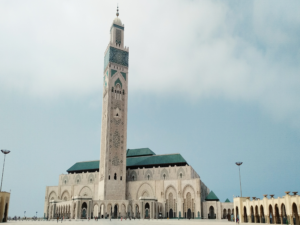
We travel north along the Atlantic coast to reach the imperial city and capital of Rabat, where we could stop for lunch if you wish. Continuing we reach the forested slopes and lakes, which means that we are approaching the blue city of Chefchaouen. You will stay in a typical hotel and have the night off to explore.
Day 2 :Rabat_chafchaouen
Today, you have the morning free to discover this magical medina with its unique urban landscape. After lunch, we depart and travel to visit the Roman ruins in Volubilis; An important city with many well preserved artifacts.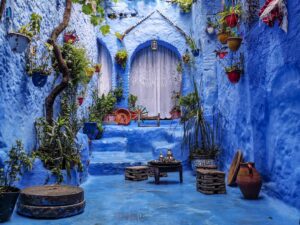 Travelling through fertile farmland and villages, we reach the ancient city of Fez and its medieval medina. Here you will spend the night with dinner and breakfast included.
Travelling through fertile farmland and villages, we reach the ancient city of Fez and its medieval medina. Here you will spend the night with dinner and breakfast included.
Day 3 : Chafchaouen_volubilis_fes
Today, you have the morning free to discover this magical medina with its unique urban landscape. After lunch, we depart and travel to visit the Roman ruins in Volubilis. An important city with many well preserved artifacts. Travelling through fertile farmland and villages, we reach the ancient city of Fez and its medieval medina. Here you will spend the night with dinner and breakfast included.
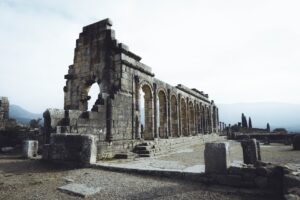
Day 4 : Explore fes
A day discovery of the city of Fez, the cultural capital and the oldest of the Imperial Cities of the country, which was for centuries the cultural and religious center of the western Islamic world, and which was declared a World Heritage Site by UNESCO.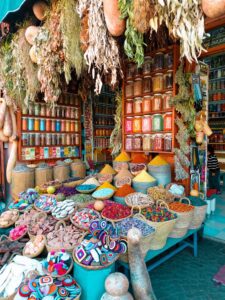
labyrinthine lanes structured by guilds of potters, dyers … and the bustle of its people will transport you centuries ago, it is a medieval city that lasts over time, 1200 years after its founding the monuments that we can visit: Medersas Koranic Schools Chahrij, Bouinania Attarin. Souks, Fes El-Jedid, Karaouine Mosque, lunch in a typical restaurant in the Medina, and free afternoon. Accommodation in Hotel or Riad.
Day 5 : Fes_Ifran_Ziz valley_Erfoud_Merzouga sahara desert
Departure by road to the beautiful dunes of Merzouga, passing through Ifran known as ‘the Moroccan Switzerland’. We will stop to visit the forest of Cedros in Azrou and see the monkeys climbing the cedars. Then we will follow the route and cross the gentle mountains of the Middle Atlas, passing through Midelt and the Ziz River, and stop to take pictures of stunning panoramic views over the gorges of this river.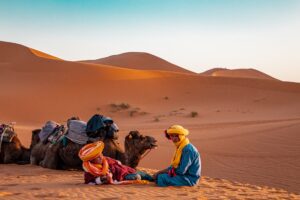
Continue to the city of Erfoud famous for the fossils that are extracted from the rocks. Arrive at the dunes of ‘Erg Chebbi’ in Merzouga, where we can feel the peace and tranquility of the desert to ride dromedaries while enjoying the sunset in the desert. An unforgettable night in the middle of the desert. dinner and accommodation in Haima Berber.
Day 6 : Merzouga_erisani_todgha gorge
Tour Around Erg Chebbi, After breakfast, we begin the drive to explore the tiny villages around Erg Chebbi dunes such as Hassi Labied, Merzouga, and Khamlia. In Hassi Labied we will stop at the garden where you will view the canal irrigation system. From here we continue on the trail toward Merzouga. Near Merzouga, you will have the chance to see Dayet Srji lake that forms in the springtime which attracts flocks of pink flamingos and wildlife, Bird-watchers will enjoy this peaceful area.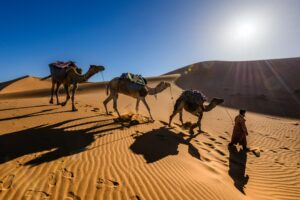
On our way to Khamlia we expect to meet locals showing their desert foxes. You may also encounter desert reptiles and mammals. In Khamlia, known as the village of black people who were once slaves from Sudan. You will be hospitably welcomed with a cup of tea (Whiskey Berber) while enjoying their spiritual Gnawa music. Leaving Khamlia, our next stop is on the panoramic view of golden dunes near the Algerian border.
We may stop for a picnic lunch under the shadow of a tree before continuing to visit a Nomad family, who live under Berber tents while taking care of the herds of cattle, goats, and camels. You will be introduced to family members and get to know about their way of life while enjoying the taste of a nice cup of tea. After this, you will have the chance to visit the sites of black volcanic rocks. Continuing on, we reach the panoramic view near Yasmina Auberge where you will be amazed at the scene of the dunes in addition to the nearby lake springtime.
Back to your hotel for lunch and relax.
Day 7 : Todgha gorge_dades valley_ouarzazate
Ait Ben Haddou & Ouarzazate, On this day trip to Ait Ben Haddou and Ouarzazate. You will enjoy a scenic journey into the High Atlas Mountains to the Tizi n’Tichka Pass (2,260m). Our first stop of the day is at Telouet. A village on the ‘Route of the Caravans’ from the Sahara over the Atlas Mountains to Marrakech.

Telouet has one of the most spectacular Kasbahs in the Atlas, which was once the palatial residence and headquarters of the powerful Glaoui tribe. This forgotten Kasbah holds a labyrinth of opulent rooms, maintaining a ghost of the splendor and glory of what it once beheld.
As you descend down onto the East side of Morocco you will notice a dramatic shift in the landscape changing to more arid and desert terrain.
Next, taking a little-used back road we arrive at Ait Ben Haddou. Inscribed by UNESCO in 1987 as a ‘World Heritage Site’, the Kasbah of Ait Ben Haddou is a striking example of the architecture of southern Morocco. The Kasbah, a group of earthen buildings surrounded by high walls, is a traditional pre-Saharan habitat. The houses crowd together within the defensive walls, which are reinforced by corner towers. After a guided tour of the ancient settlement be sure to walk up to the high point on the hill above the Kasbah for particularly fine views.
Day 8 : Ouarzazate_ait ben hadou_talouet_imlil
Breakfast and departure of route direction to Marrakech before following the route to Marrakech we go to the ancient Kasbah of Ait Ben Haddou, declared a World Heritage Site by UNESCO.
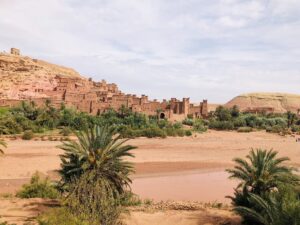
Visit the Kasbah where is where many films have been filmed, such as Obelix, Babel, the Sahara, The Kingdom of Heaven, Cleopatra, and Gladiator. Then we will follow the return route to Marrakech, crossing the mountains of the High Atlas by the Tizi n Tichka pass (the highest Atlas port, with 2,260 meters of altitude) with its spectacular views we will arrive in the afternoon to Marrakech.
ⁱˢ
Day 9 : Imlil_Essaouira
Day in the High Atlas Mountains drive across some of the most beautiful valleys to the villageof Imlil dominated by MOUNT Toubkal the highest peak in north Africa 4167m… Start a soft hike or ride a mule, to one of the highest and most picturesque berber villages. Meet the local berber people who are the earliest inhabitants of Morocco and discover their way of life and culture. during this hike you will admire breath-taking mountain sceneries. Enjoy a traditonal typical lunch in a berber home or picknick.
Overnight in Imlil in Local Gite. The High Atlas Mountains, which often dominate the skyline to the south of Marrakech, have always played an important role for the city not least with regard to commerce. Whilst Marrakech is in itself a fascinating city, a whole new experience awaits those who venture south into the mountains.
Day 10 : Explore Essaouira
Journey to discover the former Portuguese fishing village of Essaouira passing roadside towns and Berber village. During the ’60s and ’70s, Essaouira was a pit stop on the hippie trek from Marrakesh. Along the half way between Essaouira and Marrakesh you will see enormous Argan tree on both sides of the road. These Argan trees are frequently climbed by goats. Argan oil is produced by several women’s cooperatives and it is used to prepare couscous, salads. Moreover it was traditionally used as a treatment for skin diseases before being founded as good enough for cosmetics by Europeans manufacturers. Still stop by one of these cooperatives is worthy to see how Berber women squeezed the Argan fruits between hands to extract this precious oil. Visit this sea-side medieval town that boasts lovely white-washed and blue.
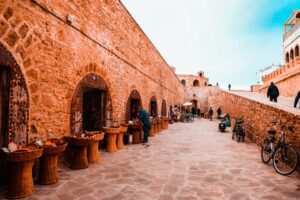
shuttered houses, colonnades, thuya wood workshops, art galleries and mouthwatering seafood. Explore Essaouira, the sea-side medieval town with lovely white-washed and blue-shuttered houses is enchanting. Learn about the local tradition of thuya wood workshops, roam the art galleries, and enjoy fresh seafood. Once called Mogador by European sailors and traders, Essaouria is known for its annual Gnaoua Music Festival that attracts 300,000+ people in June. It also has an expansive beach for surfing called Plage de Safi.
Take a stroll along the sunlit pedestrian main square, Place Prince Moulay el Hassan, and then on to Skala du Port, the fishing harbor, offers breathtaking views of the Portuguese ramparts. Explore the ramparts, the spice and jewelry souks of the medina, and the Jewish Mellah.
The medina of Essaouira is a UNESCO World Heritage Site because it is a well-preserved example of a late 18th century fortified town. Have lunch at the fish grill cafes with wooden tables and benches laid out overlooking the sea. After lunch visit Orson Welles’ Square and memorial, designed by Samir Mustapha, one of the towns artists, which pays homage to the filming of Othello in Essouaria. return to Maarrakech in the afternoon.
Day 11 : Essaouira_Marrakech
Morning explorative journey of the city. You’ll visit the Skala Fortress; see Thuya wood carved by artisans; walk through the alleys of the medina and view hundreds of handicrafts. Today you will have lunch in a Moroccan way, bought fishes ‘cooked to order’. On the afternoon, you will have some free time to wonder around, go to the beach and enjoy your space. Essaouira is also referred to as The “City of the wind” and it attracts surfers from all over the world.
Essaouira knew many civilisations – including the Portuguese occupation, which affects much of its architecture – however, it remains a small village with much history. Because of its size and its characteristic blue doors and washed walls, it is also regarded as Morocco’s “Jewel of the Atlantics”. There is an annual festival of “Gnawa music”, where many musical groups come from different parts of Africa and the world. Usually it starts in the second week of June. For the visitor, the mellow atmosphere, narrow winding streets lined with colourful shops, whitewashed houses and heavy old wooden doors make it a wonderful place to stroll.
Day 12 : Explore Marrakech
Marrakech Walking Tour will allow you to see a number of historical areas of Marrakech and hear the stories and heritage of them.
The name Marrakech originates from the Amazigh Berber words mur (n) akush, which means “Land of God.” It is the third-largest city in Morocco after Casablanca and Rabat and lies near the foothills of the snow-capped Atlas Mountains.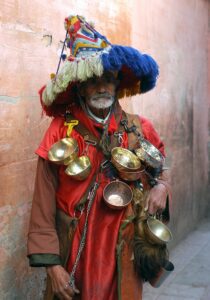
The city is divided into two distinct parts: the Medina, the historical city, and the new European modern district is called Gueliz or Ville Nouvelle. The Medina is full of intertwining narrow passageways and local shops full of character. In contrast, Gueliz plays host to modern restaurants and fast food chains and big brand stores.
There is much to see and do in Marrakech. An entire day can be dedicated to wandering around all the different souks, seeking out the best bargains. The city also offers several historical and architectural sites as well as some interesting museums. Taking this Marrakech walking tour will give you the opportunity to see all of these without missing any out.
We’ll take you to see the monuments and palaces of Marrakech on a full-day private tour. You’ll enjoy the city’s historic gardens and the artists and entertainers at Djemaa el-Fna square and experience the exotic atmosphere of the medinas and souks. Places of interest include Djemaa El-Fna, The Souks, Koutoubia Mosque, Saadian Tombs, Dar Si Said Museum, El Bahia Palace, El Badi Palace, and The Menara Gardens.
Day 13 : Departure day
Your trip ends today after breakfast. Check-out time is usually around midday
and you are free to leave at any time. We will arrange a private airport transfer
you will be advised of the pick-up time. Additional accommodation can be pre booked if you wish to spend more time exploring here. Transfer to the airport
according to your flight details.
What’s included?
- A very comfortable and air-conditioned
- Fuel for entire journey
- English speaking tour guide/chauffer during the tour(including local guides in the imperial cities) (you can specify other languages).
- Visit to Hassan2Mosque
- All nights accommodations in suite room Hotel + desert Camp
- Camel trekking
- Berber music and animation
- Dinner sand Breakfasts during the tour (vegetarian welcome)check itinerary for details.
- Daily Breakfasts.
- Marrakech, Fes, Rabat, Volubilis city sightseeing with local guides
- Pick up &drop off at Hotels /Airport.
- Authentic and unique experiences.
What’s not included?
- Flights tickets &Travel insurance.
- All Lunches, dinners (see it cinerary)
- Drinks
- Tips for your guides and driver, Porters
- Extra
- Monuments Entrances fees.
